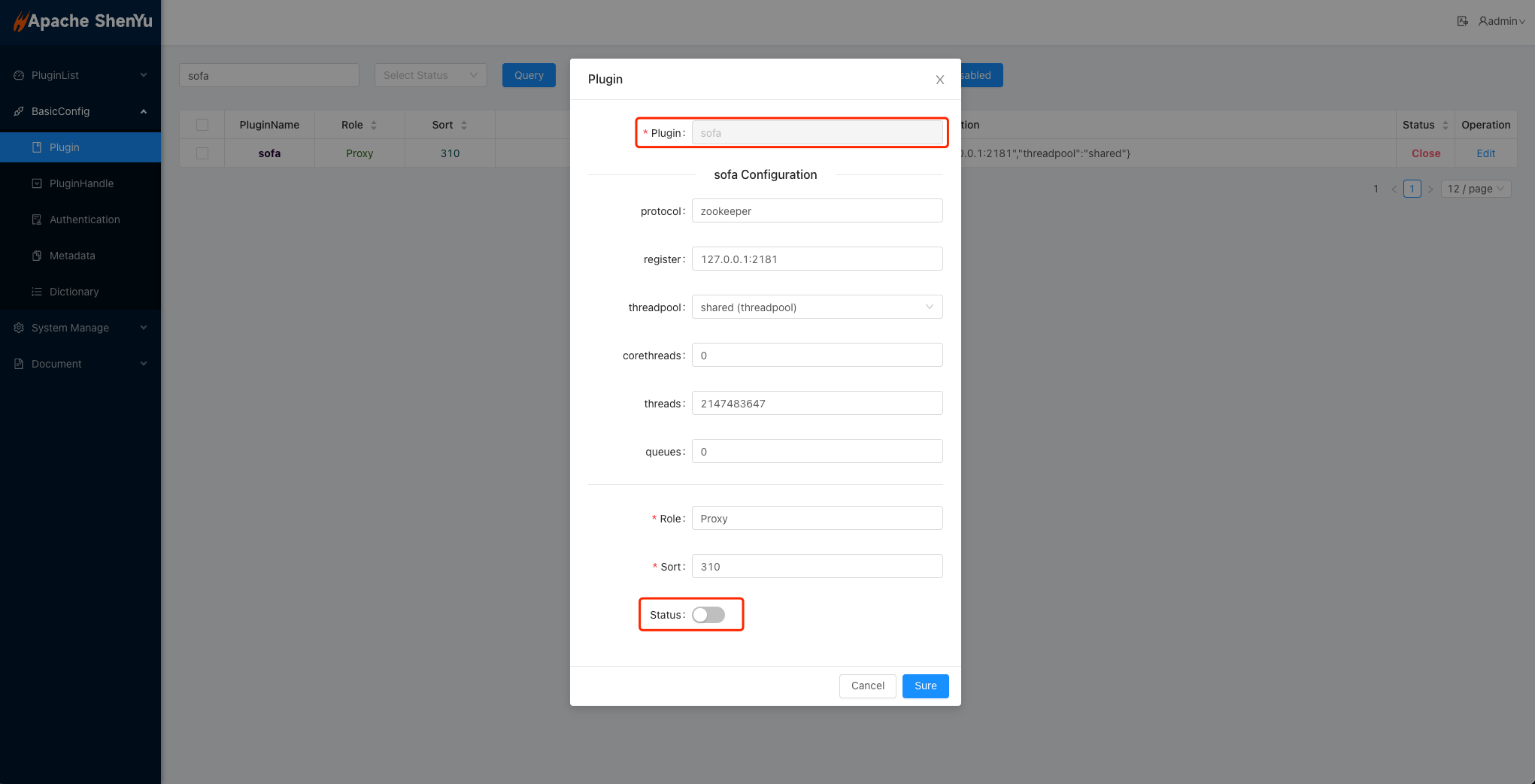1. Overview
1.1 Plugin name
- Sofa plugin
1.2 Appropriate scenario
- Protocol conversion, a plugin that converts http protocol requests into the sofa framework protocol
- Service Load Balancing.
1.3 Plugin functionality
- Converting http protocol requests to sofa framework protocol.
1.4 Plugin code
- Core Module
shenyu-plugin-sofa - Core Class
org.apache.shenyu.plugin.sofa.SofaPlugin
1.5 Added since which shenyu version
- 2.3.0
2. How to use plugin
2.1 Plugin-use procedure chart
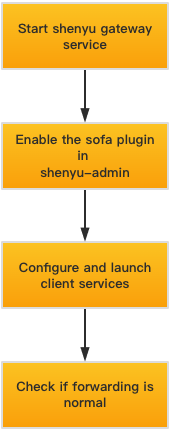
2.2 Import pom
<dependency>
<groupId>com.alipay.sofa</groupId>
<artifactId>rpc-sofa-boot-starter</artifactId>
<version>${rpc-sofa-boot-starter.version}</version>
</dependency>
<dependency>
<groupId>org.apache.shenyu</groupId>
<artifactId>shenyu-spring-boot-starter-client-sofa</artifactId>
<version>${project.version}</version>
<exclusions>
<exclusion>
<artifactId>guava</artifactId>
<groupId>com.google.guava</groupId>
</exclusion>
</exclusions>
</dependency>
2.3 Configure in the client project
- Configure the sofa configuration in application.yml.
com:
alipay:
sofa:
rpc:
registry-address: zookeeper://127.0.0.1:2181 # consul # nacos
bolt-port: 8888
shenyu:
register:
registerType: http #zookeeper #etcd #nacos #consul
serverLists: http://localhost:9095 #localhost:2181 #http://localhost:2379 #localhost:8848
props:
username: admin
password: 123456
client:
sofa:
props:
contextPath: /sofa
ipAndPort: sofa
appName: sofa
port: 8888
- Configure the service interface exposed by the sofa service in the xml file in the resources directory.
<beans xmlns="http://www.springframework.org/schema/beans"
xmlns:xsi="http://www.w3.org/2001/XMLSchema-instance"
xmlns:sofa="http://sofastack.io/schema/sofaboot"
xsi:schemaLocation="http://www.springframework.org/schema/beans http://www.springframework.org/schema/beans/spring-beans.xsd
http://sofastack.io/schema/sofaboot https://sofastack.io/schema/sofaboot.xsd"
default-autowire="byName">
<!-- 示例 sofa 接口 -->
<sofa:service ref="sofaSingleParamService" interface="org.apache.shenyu.examples.sofa.api.service.SofaSingleParamService">
<sofa:binding.bolt/>
</sofa:service>
<!-- 示例 sofa 接口 -->
<sofa:service ref="sofaMultiParamService" interface="org.apache.shenyu.examples.sofa.api.service.SofaMultiParamService">
<sofa:binding.bolt/>
</sofa:service>
</beans>
- Add the
@ShenyuSofaClientannotation to the interface.
@ShenyuSofaClient("/demo")
@Service
public class SofaClientMultiParamServiceImpl implements SofaClientMultiParamService {
@Override
@ShenyuSofaClient("/findByIdsAndName")
public SofaSimpleTypeBean findByIdsAndName(final List<Integer> ids, final String name) {
return new SofaSimpleTypeBean(ids.toString(), "hello world shenyu sofa param findByIdsAndName :" + name);
}
}
2.4 Enable plugin
-
In shenyu-admin --> BasicConfig --> Plugin -->
sofaset Status enabled.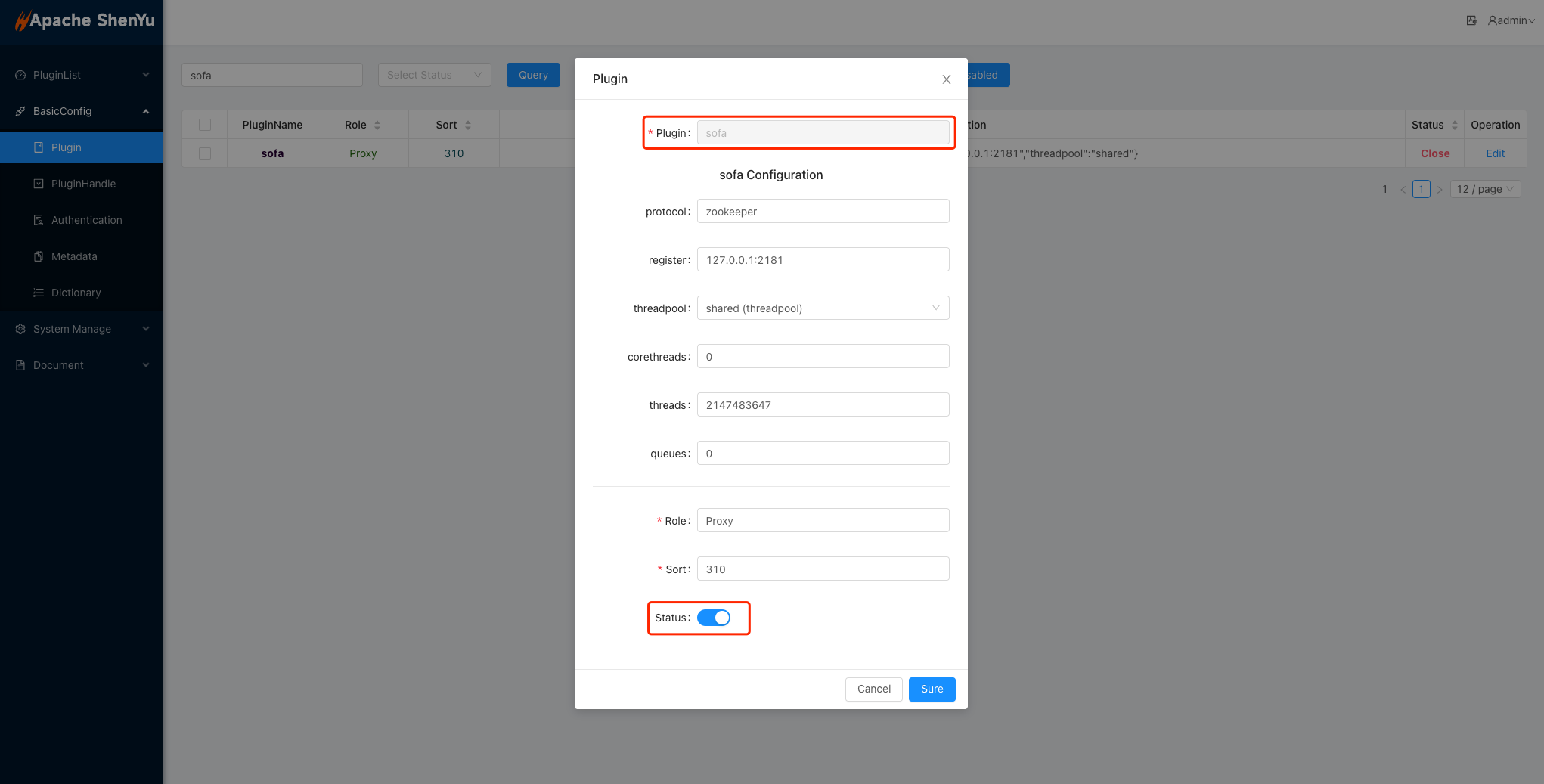
2.5 Config plugin
2.5.1 Registry Config
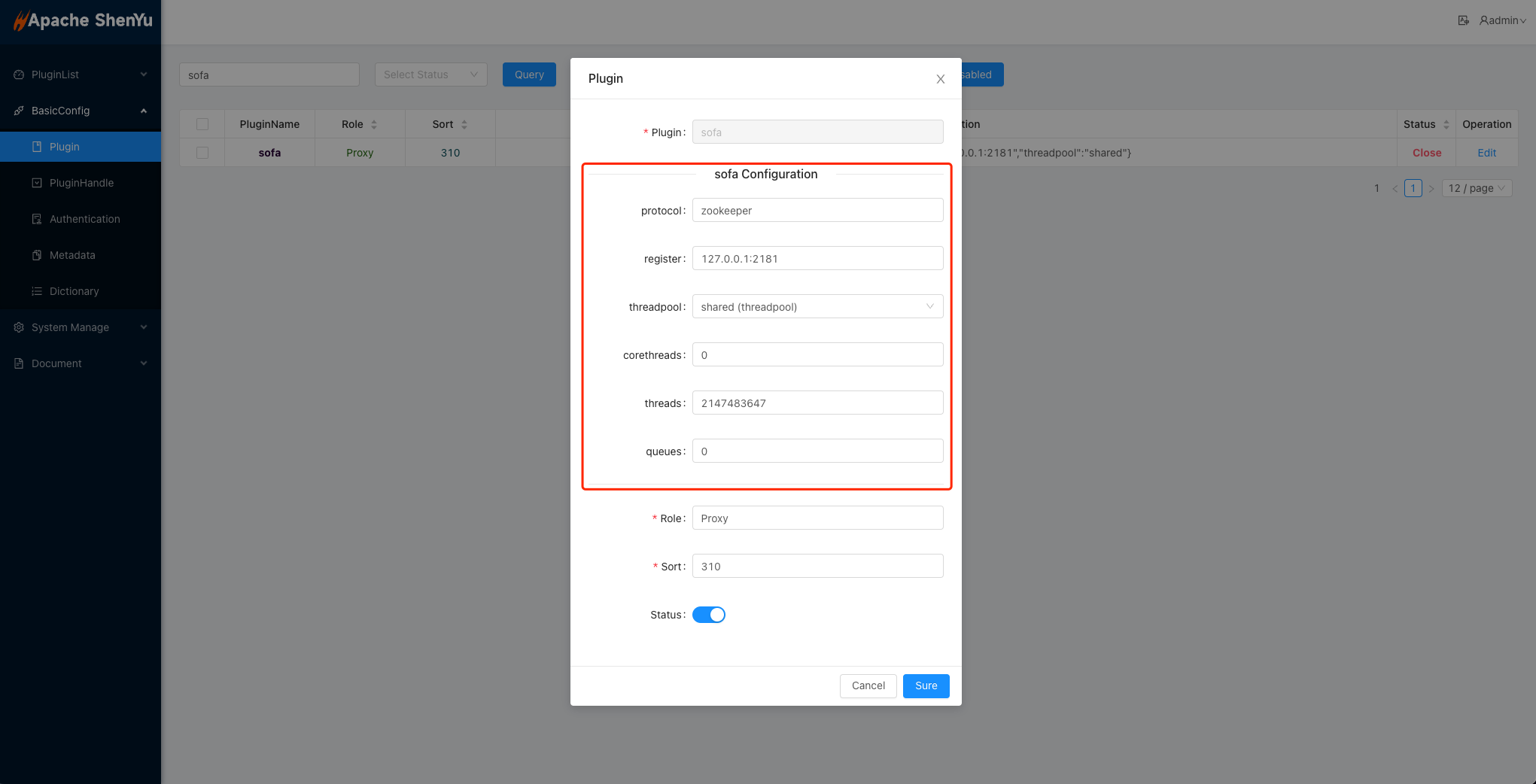
protocol: Register center protocol, currently supports zookeeper、consul、nacos.register: The service IP and PORT of the registry.threadpool:There are five types of business thread pools:fixed,eager,cached,limitedandshared. The first 4 types correspond to the thread pools officially provided by dubbo. Let's talk aboutshared, as its name implies,all proxy pluginsshare asharedthread pool, the advantage of this is that it can reduce the number of thread pools, thereby reducing memory and improving resource utilization.corethreads:The number of core threads in the business thread pool.threads:The maximum number of threads in the business thread pool.queues:The length of the blocking queue of the business thread pool, 0 meansunbounded blocking queue.
2.5.2 Selector config
Flow needs to be matched by selector.
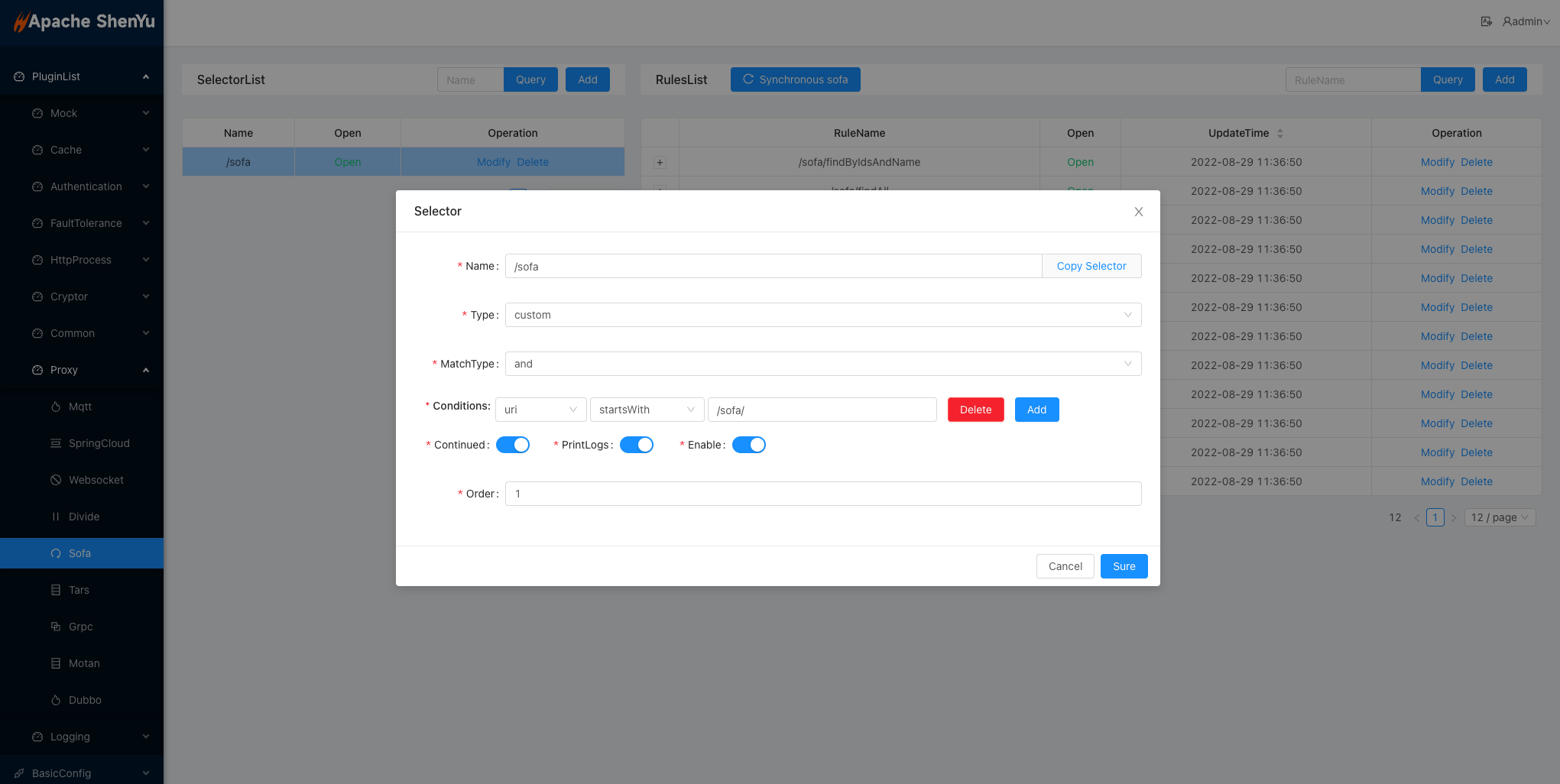
- Automatically configure the selector with the
@ShenyuSofaClientannotation.
2.5.3 Rule Config
After the traffic has been successfully matched by the selector, it will enter the rules for the final traffic matching.
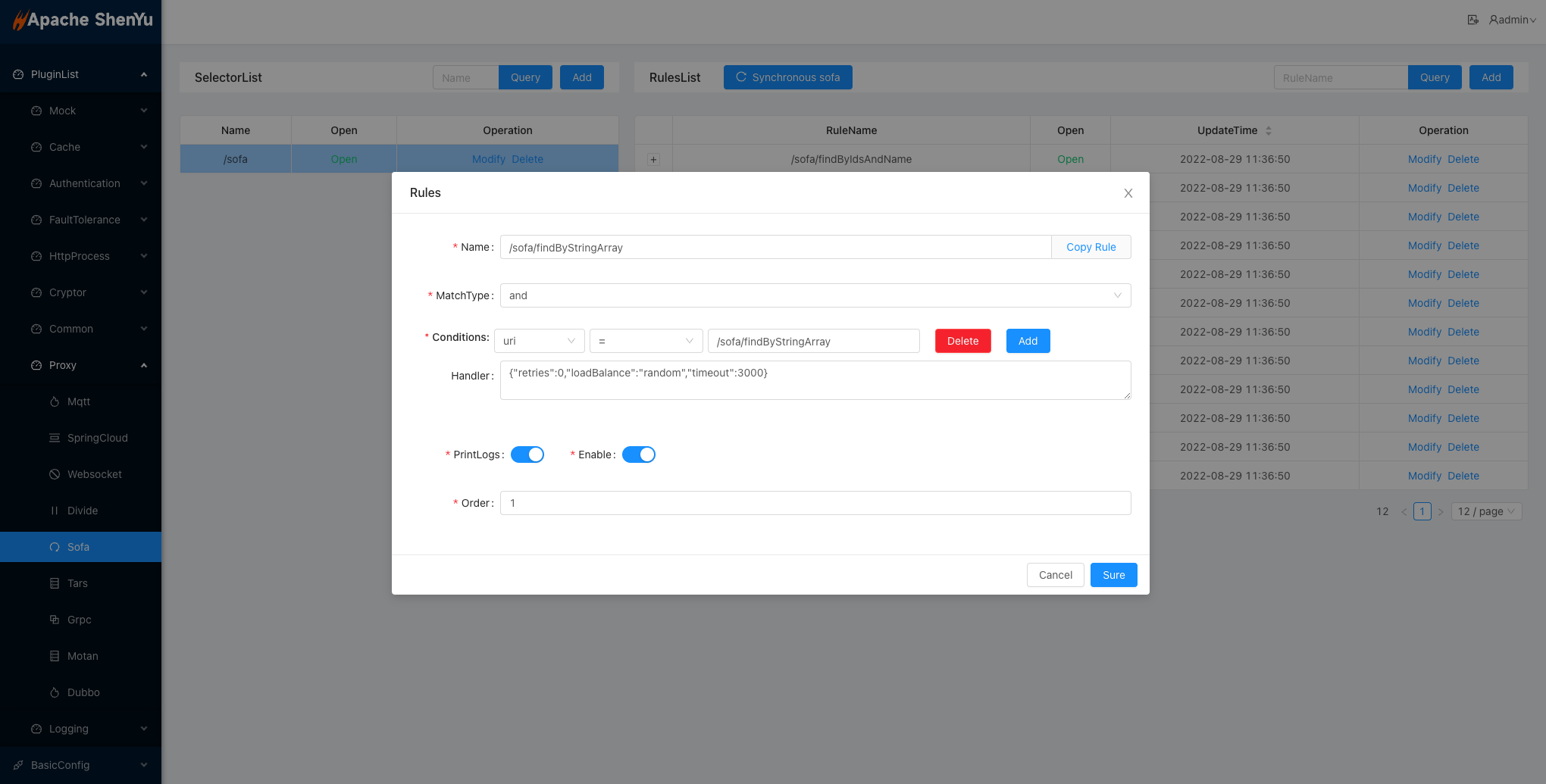
- Automatically configure the selector with the
@ShenyuSofaClientannotation.
2.5.4 Metadata config
When the
sofaapplication client accesses theApache ShenYugateway, it will be automatically registered, and can be viewed in the-shenyu-adminbackend management system's basic configuration-->metadata management, eachsofainterface method, will correspond to a metadata.
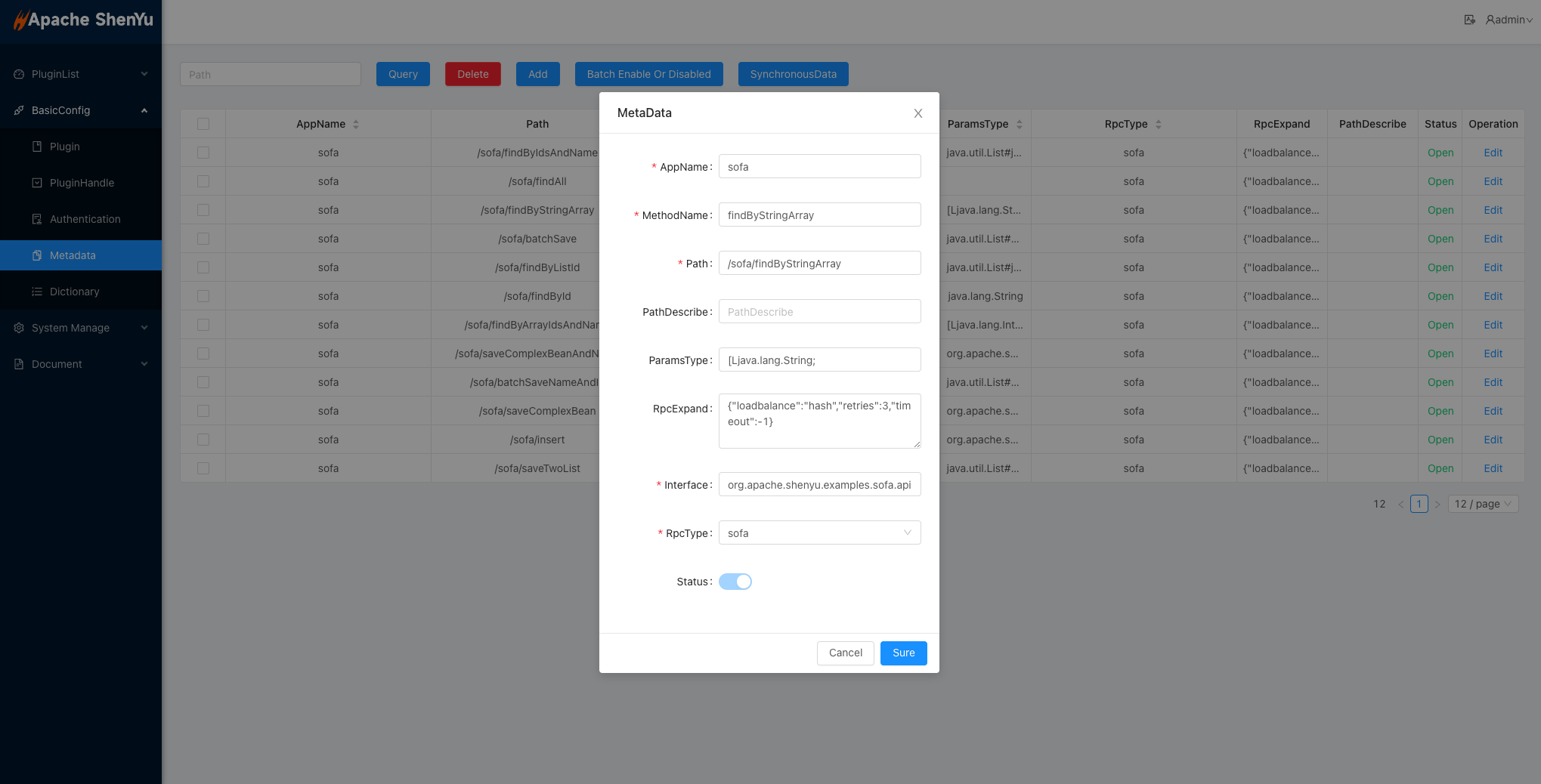
-
AppName: specifies the name of the application to which the metadata belongs.
-
MethodName: the name of the method to call.
-
Path: http request path.
-
PathDescribe: the description of the path is easy to view.
-
ParamsType: the parameters are separated by commas (,) in the order of interface parameter types.
-
RpcExpand: other configurations of the
sofainterface, which support theJSONformat.examples:
{"loadbalance":"hash","retries":3,"timeout":-1}loadbalance:Load balancing policy, currently supports roundRobin, random and hash.retries:Number of retries to call client timeout failures.timeout:Calling the client's timeout time.
-
Interface: The fully qualified class name of the
sofainterface. -
RpcType:choose
sofa.
2.6 Examples
2.6.1 Accessing the sofa service via Zookeeper using ShenYu
2.6.1.1 Preparation
- Start
Zookeeperservice. - Start
ShenYu Admin. - Start
Shenyu Bootstrap.
2.6.1.2 Plugin Config
- In shenyu-admin --> BasicConfig --> Plugin -->
sofaset Status enabled, And adjust the registry configuration as needed. - Adjust to the actual situation shenyu-examples-sofa application.yml configuration in the project and start it.
2.6.2.6 Request service and check result

3. How to disable plugin
- In
shenyu-admin--> BasicConfig --> Plugin -->sofaset Status disable.
